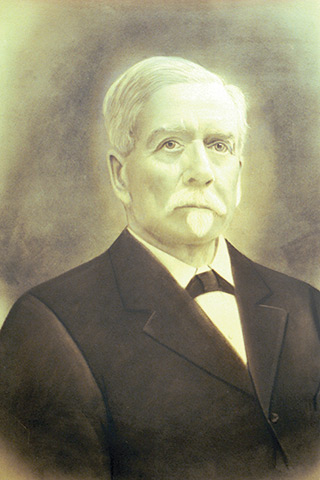History of Ricketts Glen State Park

Portrait of Colonel Ricketts
At the outbreak of the American Civil War in 1861, Robert Bruce Ricketts enlisted as a private in the U.S. Army. Fighting for the Grand Army of the Potomac, Ricketts led Battery F during the Battle of Gettysburg. Ricketts swiftly moved up in the ranks and when the war ended, was discharged a colonel.
Colonel Ricketts at one time owned outright or controlled more than 80,000 acres of land in this area.
His heirs, through the Central Penn Lumber Company, sold 48,000 acres to the Pennsylvania Game Commission from 1920-24. This left them with more than 12,000 acres surrounding the Ganoga Lake, Lake Jean, and Glens area.
Although the area was approved as a national park site in the 1930s, World War II brought an end to this plan for development. In 1942, the heirs sold 1,261 acres, the Falls and Glens area, to the Commonwealth of Pennsylvania for a state park.
Additional purchases from Colonel Ricketts’ son, William Ricketts, in 1943 and 1949, resulted in a park nucleus of approximately 10,000 acres of former Ricketts holdings. Additional purchases from other individuals brought the park to its present size.
Recreational facilities first opened in 1944. During 1950, the former Department of Forests and Waters replaced Lake Jean Dam with a larger, earthen dam, which combined Lake Jean with Mud Pond, creating the current 245-acre lake.
Other facility improvements and constructions have been done over the years, like the beach house, restrooms, and cabins.
History of the Glens Natural Area
In 1868, Colonel R. Bruce Ricketts bought land in northeast Pennsylvania to timber it. Fishermen exploring the lower reaches of Kitchen Creek discovered waterfalls. Explorations revealed that two branches of Kitchen Creek cut through deep gorges in a series of waterfalls then united at Waters Meet and flowed through a glen among giant pines, hemlocks, and oaks. Colonel Ricketts built trails to the area of the waterfalls, which came to be known as the Glens Natural Area.
A member of the Wyoming Historical and Geological Society, Col. Ricketts named many of the waterfalls after American Indian tribes. He also named waterfalls for his friends and family.
The lower glen came to be called Ricketts Glen. Many of the magnificent trees in this area are more than 300 years old. Diameters of almost four feet are common and many trees tower to 100 feet in height. The area is the meeting ground of the southern and northern hardwood types, creating an extensive variety of trees.
The Glens became a registered National Natural Landmark during 1969, and, during 1993, became a State Park Natural Area to be protected and maintained in a natural state.